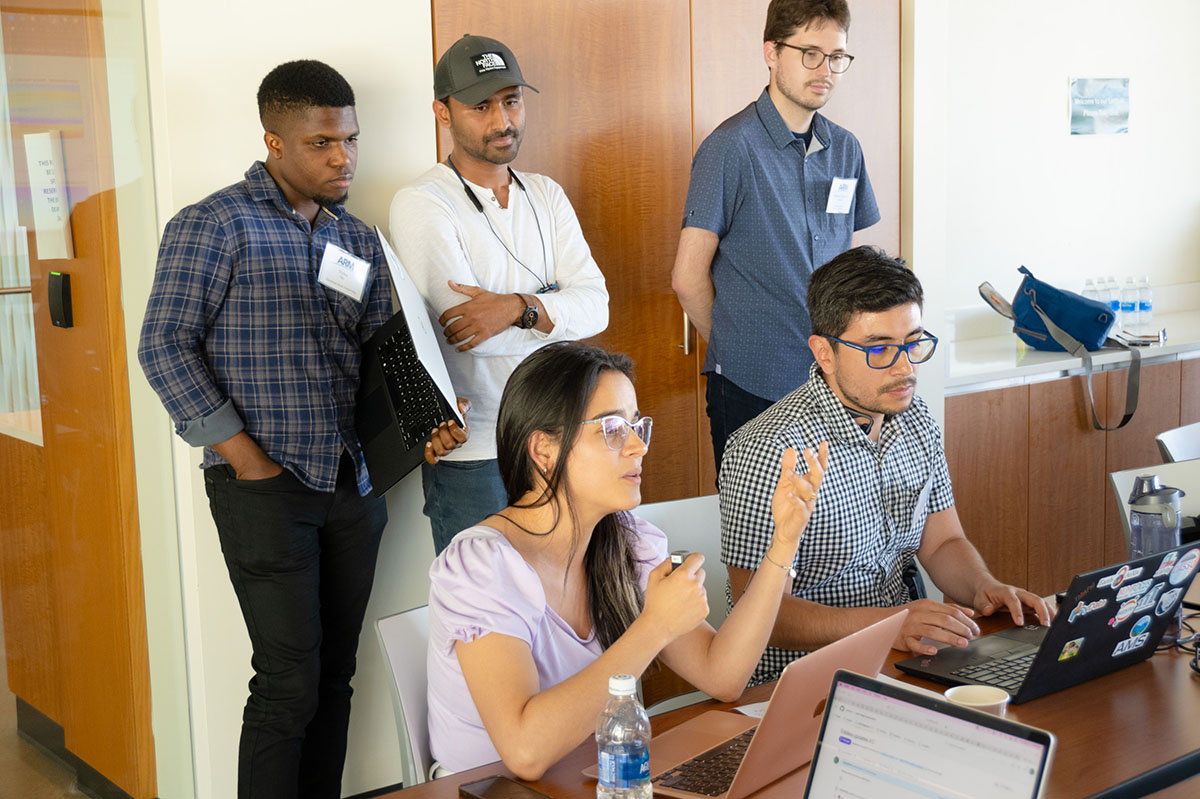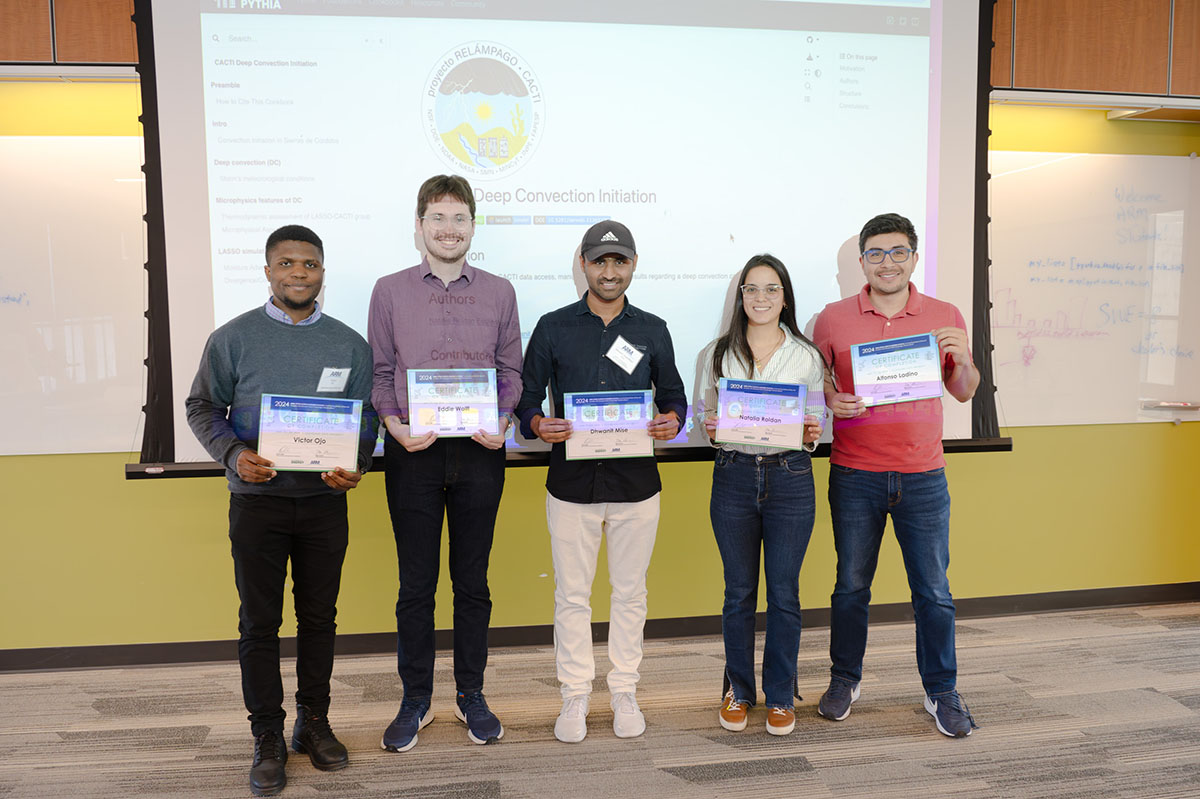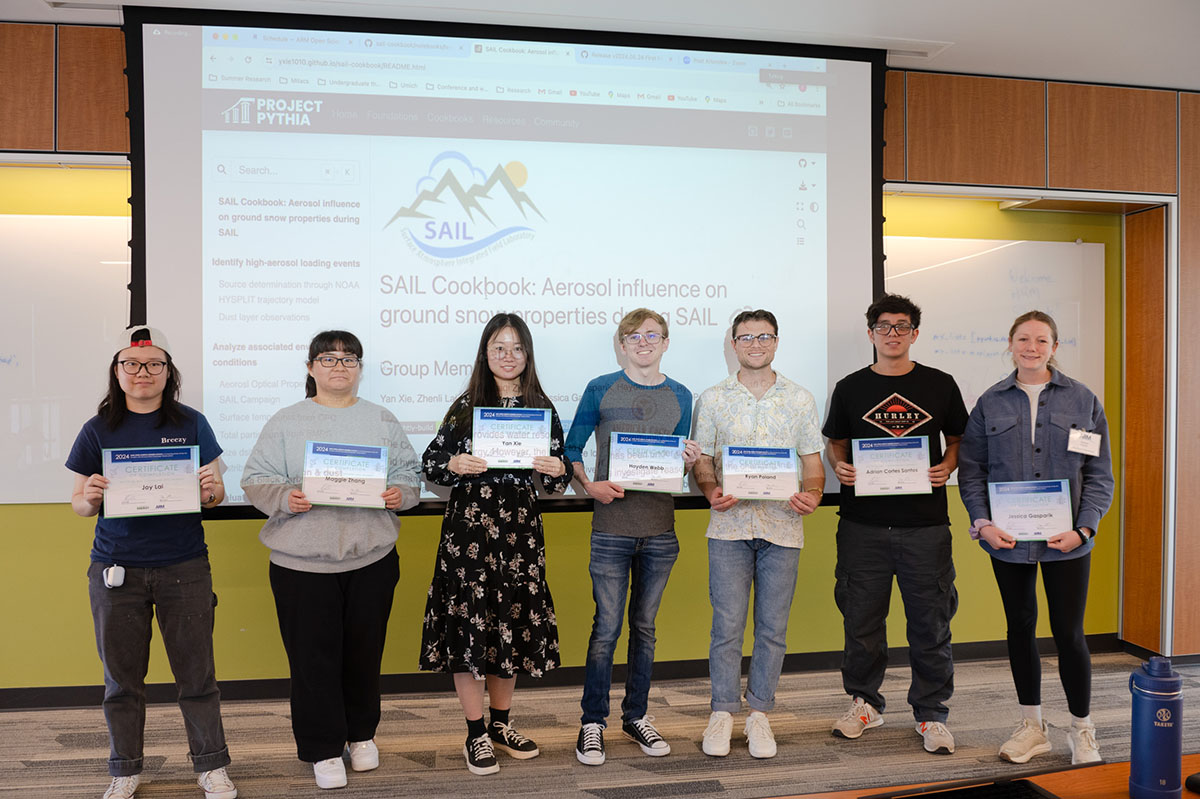Students Cook Up Recipes for Combining ARM Observations and Models
Published: 26 July 2024

The goal for this year’s ARM Open Science Summer School at Cleveland State University was all focused around training attendees on how to combine the open-source tools supported by ARM and data collected from ARM field campaigns for their own projects. In the spirit of open science, most of the lectures had at least some component focused on Jupyter Notebooks, which students could adapt for their own workflows.
Students were prompted with the challenge of designing a project related to one of the following field campaigns or sites:
- the Southern Great Plains (SGP) atmospheric observatory in Oklahoma
- the Cloud, Aerosol, and Complex Terrain Interactions (CACTI) campaign in Argentina
- the Cold-Air Outbreaks in the Marine Boundary Layer Experiment (COMBLE) in Norway
- the Surface Atmosphere Integrated Field Laboratory (SAIL) campaign in Colorado.
During the week, the students learned how they could use the open-source tools to connect observations with high-resolution model data, such as those from the Large-Eddy Simulation (LES) ARM Symbiotic Simulation and Observation (LASSO) activity.
All four groups applied the open-source tools to their data sets throughout the week, developing collections of Jupyter Notebooks that showcased their scientific analysis. At the end of the week, Digital Object Identifiers (DOIs) were minted, ensuring each group had a citable scientific object.
The summer school was an exercise in open science collaboration, from initial scientific questions, hypotheses, exploratory analyses, final presentations, and DOI minting for future citations.
Learn more about the students and their projects below.
Large-Scale Forcing Impact on Shallow Cumulus Fields Over SGP
Team members: Theresa Lincheck, University of Oklahoma; Xena Mansoura, Pacific Northwest National Laboratory; Tessa Rosenberger, Cleveland State University; Girish Nigamanth Raghunathan, Cleveland State University; Kyoungho Ryu, Boston University
Science questions:
- What does the organization and structure of the shallow cumulus field look like in LASSO simulations on April 4, 2019?
- How does this organization and structure of shallow cumulus differ from observations on April 4, 2019?
- How does near-surface moisture influence evolution of shallow cumulus?
Hypotheses:
- The scale of large-scale forcing that will yield results closest to observations, depends on the date—there is no “one-size-fits-all” scale size.
- Increased surface moisture will cause earlier timing of shallow cumulus creation and deeper clouds (looking at observations on LASSO case dates).
Outcomes: The large-scale forcing scales impact cloud core fraction due to differences in turbulent kinetic energy. The model should carefully choose the large-forcing length scale to represent the environment appropriately on a given day.
CACTI Deep Convection Initiation
Team members: Alfonso Ladino, University of Illinois Urbana-Champaign; Dhwanit Mise, University of Oklahoma; Victor Ojo, University of North Dakota; Natalia Roldan, University of Maryland; Eddie Wolff, University of Illinois Urbana-Champaign
Science question: How is deep convection initiation controlled by local and regional meteorological conditions (thunderstorm life cycle) as well as geography?
Hypothesis: Convection initiation near the ARM site is caused largely by orographic effects, surface heating, and advection of moisture from the Pacific.
Outcomes: Based on LASSO data, it appears that the terrain is playing a role in initiating convection with convergence along the ridge of the mountain range adding lift to initiate convection. Subsequently, outflow from the initial storms generates more convergence and lift to help initiate more convection.
View the CACTI team’s cookbook.
Comparing Cold-Air Outbreak Conditions at COMBLE and the North Slope of Alaska (NSA)
Team members: Jordan Eissner, University of Kansas; Oye Ideki, Howard University; Hannah Seppala, University of Maryland, Baltimore County; Shivesh Sharma, Cleveland State University; Nirmal Mathew Alex, Florida Institute of Technology; Ines Zabala, University of Granada
Science questions:
- How do aerosol (concentration, cloud condensation nuclei, ice nuclei) conditions vary between the sites?
- How do boundary layer (surface fluxes, turbulence) and cloud structures (cell type, characteristic size, phase) vary between the sites?
Hypotheses:
- Cloud condensation nuclei and aerosol concentration will be smaller than average the day after cold-air outbreak (CAO) events due to precipitation scavenging.
- CAO index will be positively correlated with surface flux and wind direction/intensity.
- Clouds at the NSA will have different physical formation and be less glaciated due to younger age.
Outcomes:
- Sites have significantly different cloud types (stratiform at the NSA, cellular at COMBLE) and phase (mixed phase at the NSA, ice at COMBLE) due to location within CAO events.
- Events correspond with winds that are more northerly than average.
- CAO events in COMBLE can affect aerosol and CCN concentrations as well as aerosol activation properties.
- Both sensible and latent heat fluxes are correlated with the CAO index. Strong events show higher fluxes and comparatively stronger diurnal cycles.
- LES can be used to help explain cloud microphysical properties associated with differing event strengths and locations.
View the high-latitude team’s cookbook.
Aerosol Influence on Ground Snow Properties During SAIL
Team members: Adrian Cortes Santos, University of Puerto Rico; Jessica Gasparik, Brookhaven National Laboratory; Joy Lai, Pacific Northwest National Laboratory; Ryan Poland, University of Georgia; Hayden Webb, University of Oklahoma; Yan Xie, University of Michigan; Maggie Zhang, Washington University in St. Louis
Science questions:
- Where do peak dust and black carbon events occur?
- How do these peaks correlate with changes in surface albedo/surface shortwave radiation?
- How does snowpack change around these events?
Hypotheses:
- Decreases in local surface albedo will correlate with high aerosol loading events.
- Increased surface heating results in snowpack depth decrease following high aerosol loading events.
- The Weather Research and Forecasting (WRF) model does not implement aerosols in simulations and, therefore, could mispredict the snow radiation fluxes following aerosol events.
Outcomes: The team used the SAIL campaign measurements to perform a case study of three events, including one control event and two high aerosol loading events. In situ measurements and back-trajectory model output were used to evaluate the number concentration and size distribution of aerosols and black carbon. Analysis of longwave radiation measurements further confirmed that there was a high concentration of black carbon/aerosols in the atmosphere. Snow albedo decreases were observed in the two high aerosol loading events. Meanwhile, WRF simulations did not capture such decreases in surface albedo. Because the WRF simulations used in this project did not incorporate aerosols, the team expects aerosols, along with other factors, can contribute to such a discrepancy between measurements and WRF simulations in terms of the snow-darkening effect of aerosols/black carbon.
View the SAIL team’s cookbook.
Keep up with the Atmospheric Observer
Updates on ARM news, events, and opportunities delivered to your inbox
ARM User Profile
ARM welcomes users from all institutions and nations. A free ARM user account is needed to access ARM data.






















